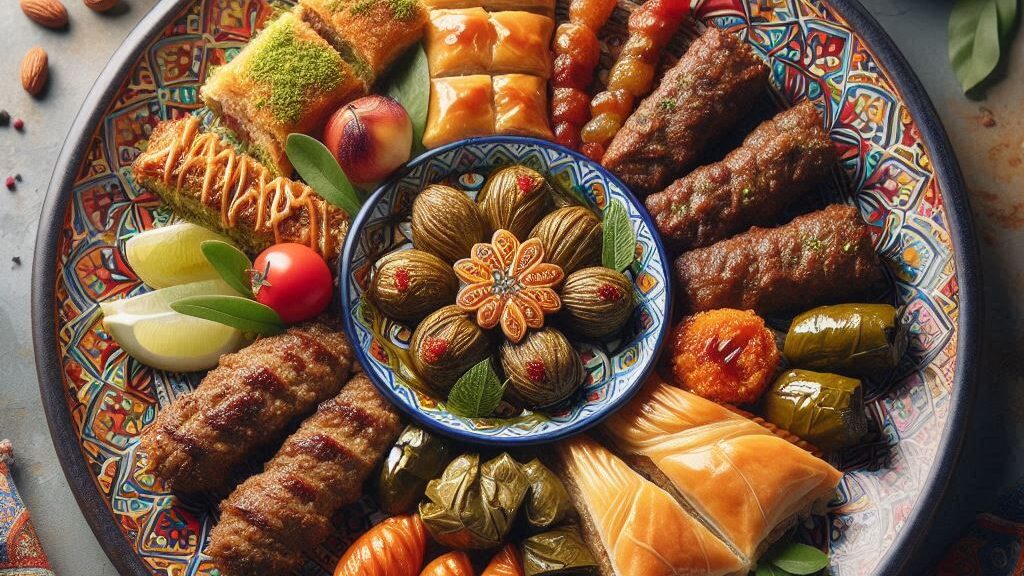Discover Turkey’s Culinary Delights: Traditional Dishes and Flavors
Turkish cuisine is a vibrant tapestry woven from centuries of history, cultural diversity, and geographical influences. From the bustling streets of Istanbul to the serene shores of the Mediterranean, Turkish food reflects a blend of Middle Eastern, Mediterranean, Balkan, and Central Asian flavors.

Traditional Turkish Dishes
Delve into the rich tapestry of flavors that define Turkish culinary heritage:
1. Kebabs
Adana Kebab
Originating from the city of Adana in southern Turkey, this spicy kebab is made from minced lamb or beef mixed with red pepper flakes and grilled to perfection.
Iskender Kebab
A specialty from Bursa, Iskender kebab features thinly sliced lamb or beef served over pieces of pide bread, topped with tomato sauce and yogurt.
Shish Kebab
Chunks of marinated meat (typically lamb or chicken) grilled on skewers, often served with rice or bulgur pilaf and grilled vegetables.
2. Mezes
Hummus
A beloved appetizer made from pureed chickpeas, tahini (sesame paste), lemon juice, garlic, and olive oil, served with fresh bread or vegetables.
Dolma
Stuffed vegetables (such as grape leaves, peppers, and tomatoes) filled with a mixture of rice, herbs, nuts, and spices, a staple dish in Turkish cuisine.
3. Seafood Dishes
Grilled Sea Bass
Fresh sea bass marinated in olive oil, lemon juice, garlic, and herbs, grilled to perfection and served with a side of salad or grilled vegetables.
Midye Dolma
Mussels filled with a flavorful mixture of seasoned rice, pine nuts, currants, and herbs, a popular street food along the Aegean and Mediterranean coasts.
4. Desserts
Baklava
Layers of thin pastry filled with chopped nuts (typically pistachios or walnuts) and sweetened with syrup or honey, a symbol of Turkish hospitality and sweetness.
Künefe
A decadent dessert made from shredded pastry soaked in sweet syrup, layered with cheese (usually unsalted white cheese), and baked until golden and crispy.
Regional Varieties of Turkish Cuisine
Turkish cuisine varies significantly by region, influenced by local ingredients, climate, and cultural traditions:
1. Aegean Region
Known for its abundance of olive oil, fresh seafood, aromatic herbs (such as oregano and thyme), and dishes like Aegean-style mezes and seafood stews.
2. Anatolian Plateau
Famous for hearty dishes like kebabs, stews (such as güveç), and pilafs (especially bulgur pilaf), reflecting the region’s agricultural traditions and use of grains.
3. Southeastern Anatolia
Characterized by spicy kebabs (like Urfa kebab), rich stews (such as çiğ köfte), and mezes influenced by Kurdish, Arabic, and Persian culinary traditions.
4. Black Sea Region
Known for its lush green landscapes and seafood-rich cuisine, featuring dishes like hamsi (anchovy) pilaf, cornbread (mısır ekmeği), and hearty soups.
Cooking Techniques and Ingredients
Turkish cuisine employs various cooking techniques and locally sourced ingredients that enhance its flavors and textures:
- Grilling: Popular for kebabs and meats, often cooked over charcoal or open flames for a smoky flavor.
- Slow Cooking: Used in dishes like stews and casseroles, allowing flavors to meld together over low heat.
- Use of Spices: Common spices include cumin, paprika, sumac, and dried mint, adding depth and complexity to dishes.
- Herbs and Greens: Fresh herbs such as parsley, dill, mint, and cilantro are used generously in salads, mezes, and main dishes.
Health Benefits of Turkish Cuisine
Turkish cuisine emphasizes fresh ingredients, olive oil, and a balanced approach to eating, contributing to its health benefits:
- Mediterranean Diet: Rich in antioxidants, healthy fats (like olive oil), lean proteins (from fish and poultry), and whole grains (such as bulgur and barley), linked to heart health and longevity.
Dining Culture and Traditions
Dining in Turkey is more than just a meal; it’s a cultural experience steeped in hospitality and tradition:
- Meze Culture: The tradition of sharing small plates (mezes) before the main course, accompanied by Turkish rakı or wine.
- Coffee and Tea: Turkish coffee, brewed finely ground beans, served with a glass of water; Turkish tea (çay), served strong and hot in tulip-shaped glasses.
- Special Occasions: Celebrations like weddings and holidays are marked with feasts featuring elaborate dishes and desserts.
Turkish cuisine is a testament to the country’s rich history, cultural diversity, and culinary innovation. Whether you’re savoring a juicy kebab, indulging in a sweet baklava, or enjoying a flavorful meze spread, Turkish food offers a gastronomic journey that delights the senses and celebrates the richness of Anatolian flavors.











I thoroughly enjoyed reading about “Discover Turkey’s Culinary Delights: Traditional Dishes and Flavors” on your blog! It was such a delightful journey into Turkey’s rich culinary heritage. The details about traditional dishes and flavors were fascinating. I can’t wait to try some of these dishes myself. The visuals were also captivating; they made me feel like I could almost taste the flavors!
Thank you to the author(s) for this wonderful content. Looking forward to reading more from you in the future!